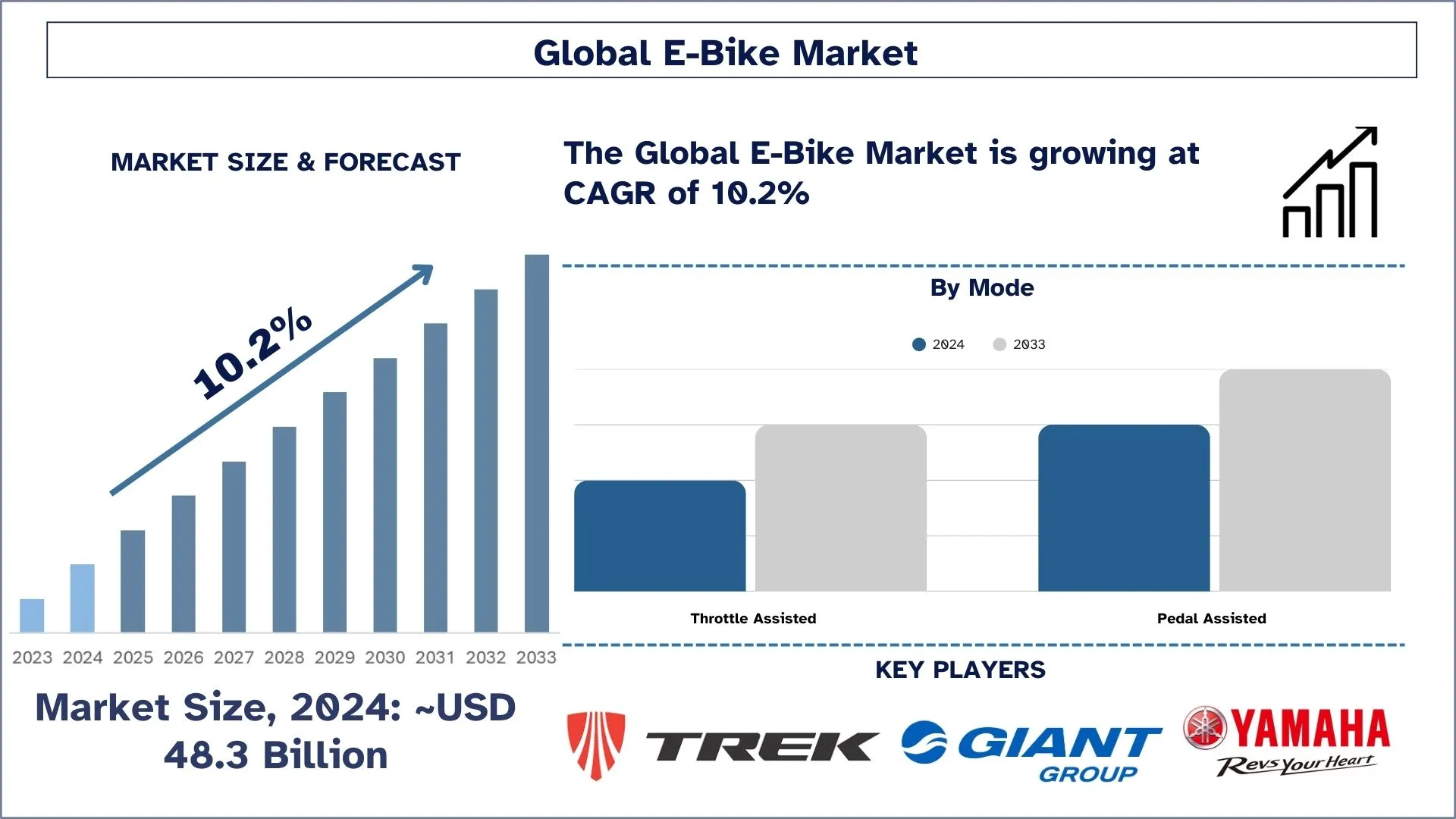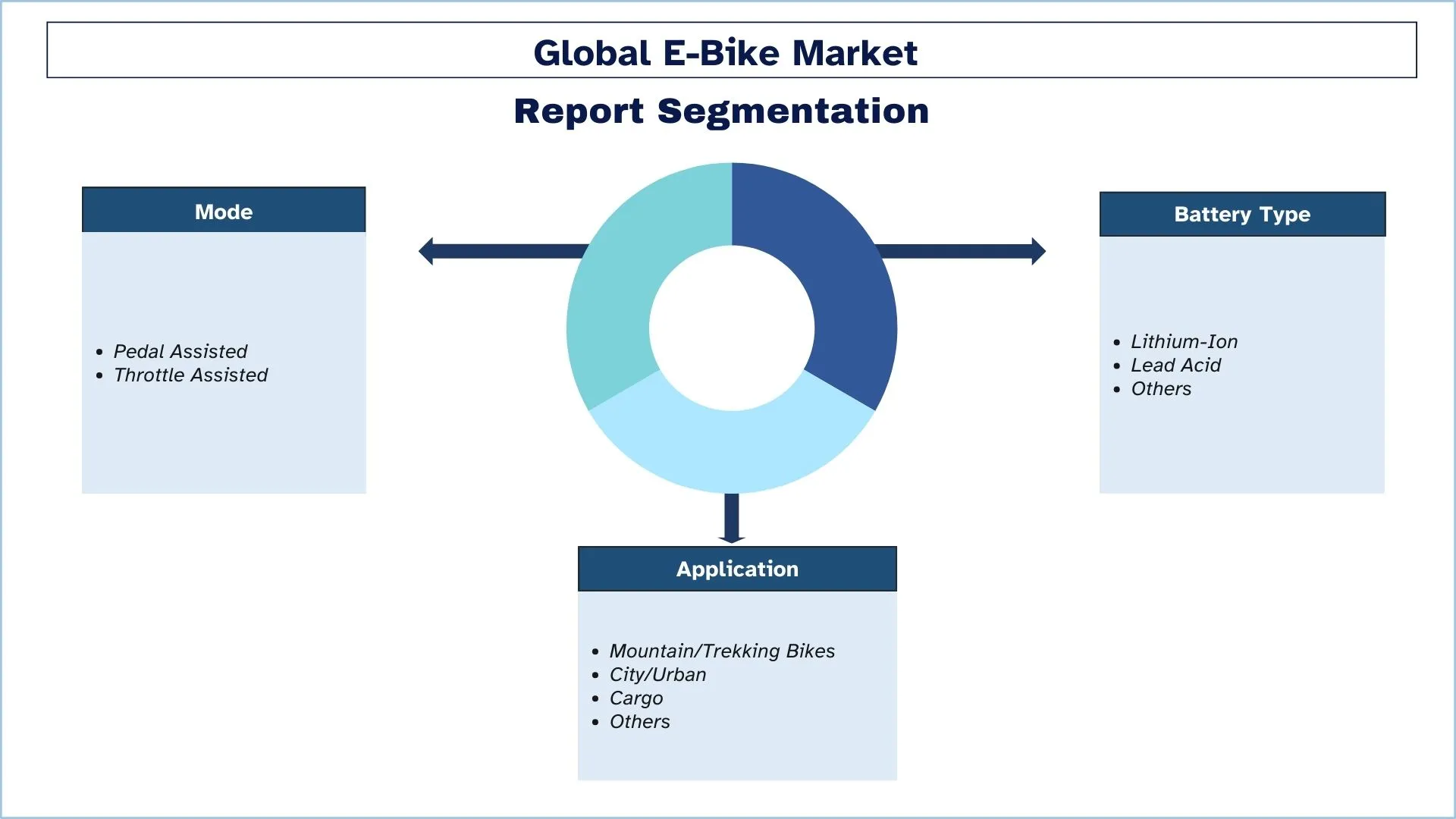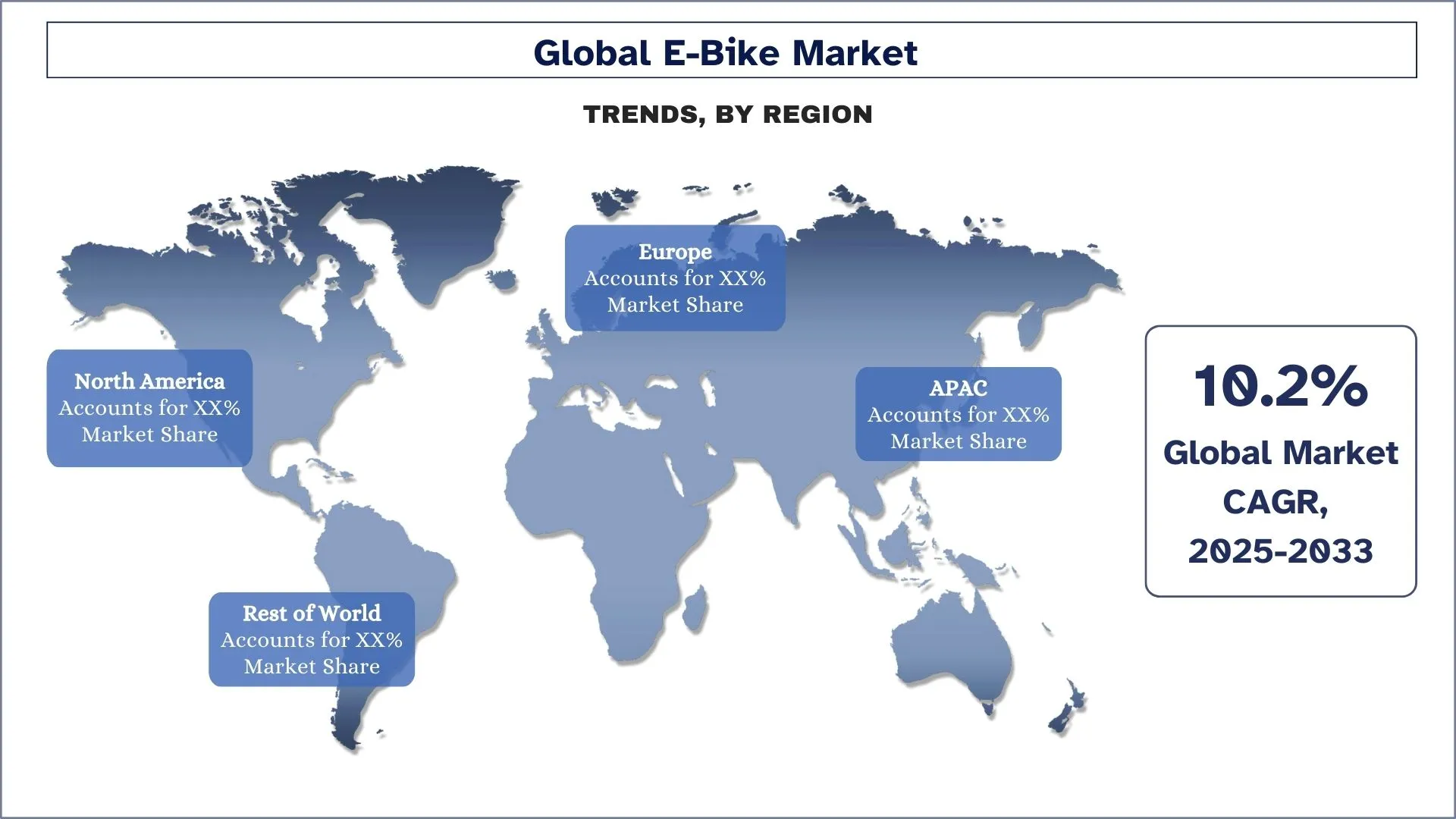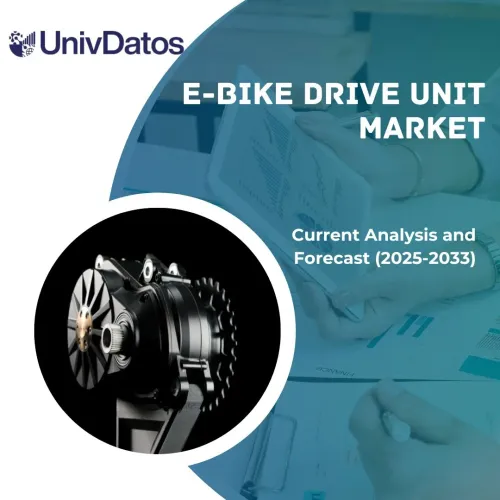- Accueil
- À propos de nous
- Industrie
- Services
- Lecture
- Contactez-nous
Marché des vélos électriques : Analyse actuelle et prévisions (2025-2033)
Accent mis sur le mode (assistance au pédalage et assistance à l'accélérateur) ; Type de batterie (lithium-ion, plomb-acide et autres) ; Application (vélos de montagne/trekking, ville/urbain, cargo et autres) ; Région et pays

Taille et prévisions du marché des vélos électriques
La valeur du marché des vélos électriques était d'environ 48,3 milliards USD en 2024 et devrait croître à un TCAC substantiel d'environ 10,2 % au cours de la période de prévision (2025-2033), en raison des préoccupations environnementales croissantes.
Analyse du marché des vélos électriques
Les vélos électriques sont un moyen de transport polyvalent, écologique et à la mode. Les consommateurs les considèrent comme une alternative viable aux scooters, aux voitures intelligentes et aux transports en commun. Les vélos électriques contribuent à réduire les embouteillages en raison de leur taille réduite, de leur capacité à atteindre des vitesses plus élevées avec moins d'efforts et des avantages pour la santé découlant du pédalage. Ces considérations ont accru la popularité des vélos électriques dans le monde entier. Le marché devrait croître en raison de facteurs tels que les réglementations gouvernementales encourageant l'utilisation des vélos électriques, la préférence des consommateurs pour les vélos électriques en tant que mode de transport écologique et efficace, la hausse des prix du carburant et l'intérêt accru pour le cyclisme en tant qu'activité de remise en forme et de loisirs. Cependant, le coût élevé des vélos électriques et l'interdiction de leur utilisation dans les grandes villes chinoises freinent l'expansion du marché. L'amélioration de l'infrastructure cyclable et de la technologie des batteries, ainsi que la réduction du coût des batteries, devraient également offrir des opportunités intéressantes pour l'épanouissement du secteur des vélos électriques.
Tendances du marché des vélos électriques
Cette section traite des principales tendances du marché qui influencent les différents segments du marché des vélos électriques, telles qu'identifiées par nos experts en recherche.
Essor des services de vélos électriques par abonnement
La mobilité partagée et par abonnement est une transformation essentielle qui définit actuellement les taux du marché international des vélos électriques. Ainsi, de nombreux resquilleurs ont facilement accès aux vélos électriques, ainsi qu'à leurs problèmes de propriété, par le biais d'entreprises ou de start-up, en particulier dans les zones urbaines. Ce modèle cible les jeunes et les clients soucieux de l'environnement et créera de nouvelles sources de revenus, d'autant plus que de plus en plus de personnes en Europe et en Amérique du Nord passent de la propriété automobile aux modèles MaaS.
Segmentation de l'industrie du marché des vélos électriques
Cette section fournit une analyse des principales tendances de chaque segment du rapport sur le marché mondial des vélos électriques, ainsi que des prévisions aux niveaux mondial, régional et national pour 2025-2033.
Le segment de l'assistance au pédalage devrait connaître un TCAC plus élevé que le marché des vélos électriques.
Selon le mode, le marché est segmenté en assistance au pédalage et assistance à l'accélérateur. Le segment des pédales devrait dominer le marché au cours de la période de prévision. Les consommateurs apprécient le mode d'assistance au pédalage car il combine les avantages de la conduite avec la commodité de l'assistance électrique pour les longues croisières. En conséquence, l'assistance au pédalage est en tête du segment des modes.
Le marché des VTT/vélos de trekking détient la plus grande part du marché.
Selon l'application, le marché est segmenté en vélos de montagne/trekking, vélos de ville/urbains, vélos cargo et autres. Le marché des vélos de montagne/trekking devrait croître à un TCAC important au cours de la période de prévision. Alors que les clients s'intéressent de plus en plus aux activités de trekking et de loisirs, la demande de vélos électriques de montagne/trekking augmente. La demande de vélos électriques de montagne/trekking augmente à mesure que les gens s'intéressent de plus en plus aux activités d'aventure axées sur la performance.

La région APAC détient une part importante du marché en 2024.
L'Asie-Pacifique devrait être le marché le plus important. Le marché des vélos électriques en Asie-Pacifique est dominé par la Chine, qui est le plus grand fabricant et exportateur de vélos électriques de la région. Les vélos électriques sont de plus en plus achetés dans toute la région pour des déplacements courts, rentables et écologiques, comme les déplacements domicile-travail ou le bureau. Dans cette région, l'Inde, le Japon et la Corée du Sud sont des marchés potentiels en raison de l'augmentation des ventes de vélos électriques dans ces pays.
La Chine domine le marché des vélos électriques en APAC
La Chine occupe une position dominante dans la production et la consommation de vélos électriques dans le monde entier. En raison des politiques gouvernementales qui encouragent la mobilité électrique et de l'interdiction des deux-roues à moteur thermique dans les villes, les vélos électriques sont devenus le moyen de transport privilégié de millions de personnes. La main-d'œuvre peu coûteuse et la vaste structure de fabrication du pays aident également les marques nationales à dominer le marché de l'exportation et fournissent une preuve supplémentaire de l'importance de la Chine dans la chaîne d'approvisionnement des vélos électriques.

Paysage concurrentiel de l'industrie du marché des vélos électriques
Le marché des vélos électriques est concurrentiel, avec plusieurs acteurs mondiaux et internationaux. Les principaux acteurs adoptent différentes stratégies de croissance pour améliorer leur présence sur le marché, telles que des partenariats, des accords, des collaborations, des lancements de nouveaux produits, des expansions géographiques, ainsi que des fusions et acquisitions.
Principales entreprises du marché des vélos électriques
Parmi les principaux acteurs opérant sur le marché figurent Yamaha Motor Corporation ; Specialized Bicycle Components, Inc. ; Accell Group (KKR & Co. Inc.) ; Giant Manufacturing Co., Ltd. ; Derby Cycle (Pon Holdings) ; Jiangsu Xinri E-Vehicle Co., Ltd. ; Karbon Kinetics Ltd ; Trek Bicycle Corporation ; Merida Industry Co. ; et Riese & Muller.
Évolutions récentes du marché des vélos électriques
En novembre 2023, Giant Group a lancé son premier vélo électrique à commande d'accélérateur, le Cito E+. Le nouveau modèle serait commercialisé sous la sous-marque Momentum de l'entreprise, qui propose des vélos plus abordables conçus pour la ville, les services publics et les déplacements domicile-travail. Le nouveau Momentum Cito E+ est doté d'une boîte à gants.
En mars 2023, Bharat Forge Limited, par l'intermédiaire de sa filiale E-Mobility, Kalyani Powertrain Limited, a inauguré sa première usine de vélos électriques en mars au MIDC Chakan. La capacité de production de l'usine est de 60 000 unités par an, qui peut être portée à 100 000 unités par an. L'usine se concentre principalement sur l'assemblage de vélos électriques pour Tork Motors Private Limited, qui est détenue à 64 % par Kalyani Powertrain Limited.
Couverture du rapport sur le marché des vélos électriques
Attribut du rapport | Détails |
Année de référence | 2024 |
Période de prévision | 2025-2033 |
Dynamique de croissance | Accélération à un TCAC de 10,2 % |
Taille du marché en 2024 | 48,3 milliards USD |
Analyse régionale | APAC, Europe, Asie-Pacifique, reste du monde |
Principale région contributrice | L'APAC devrait croître au TCAC le plus élevé au cours de la période prévue. |
Principaux pays couverts | États-Unis, Canada, Allemagne, France, Royaume-Uni, Espagne, Italie, Chine, Japon et Inde |
Yamaha Motor Corporation ; Specialized Bicycle Components, Inc. ; Accell Group (KKR & Co. Inc.) ; Giant Manufacturing Co., Ltd. ; Derby Cycle (Pon Holdings) ; Jiangsu Xinri E-Vehicle Co., Ltd. ; Karbon Kinetics Ltd ; Trek Bicycle Corporation ; Merida Industry Co. ; et Riese & Muller | |
Portée du rapport | Tendances du marché, moteurs et contraintes ; Estimation et prévisions des revenus ; Analyse de la segmentation ; Analyse de la demande et de l'offre ; Paysage concurrentiel ; Profilage d'entreprise |
Segments couverts | Par mode, type de batterie, par application, par région/pays |
Raisons d'acheter le rapport sur le marché des vélos électriques :
L'étude comprend une analyse de la taille et des prévisions du marché validée par des experts authentifiés du secteur.
Le rapport présente un aperçu rapide de la performance globale de l'industrie.
Le rapport couvre une analyse approfondie des pairs de l'industrie en mettant l'accent sur les principales données financières, les portefeuilles de produits, les stratégies d'expansion et les développements récents.
Examen détaillé des moteurs, des contraintes, des tendances clés et des opportunités prévalant dans l'industrie.
L'étude couvre de manière exhaustive le marché dans différents segments.
Analyse approfondie au niveau régional de l'industrie.
Options de personnalisation :
Le marché mondial des vélos électriques peut être personnalisé davantage selon les exigences ou tout autre segment de marché. En outre, UnivDatos comprend que vous pouvez avoir vos propres besoins commerciaux ; n'hésitez pas à nous contacter pour obtenir un rapport qui corresponde parfaitement à vos besoins.
Table des matières
Méthodologie de recherche pour l'analyse du marché des vélos électriques (2023-2033)
Nous avons analysé le marché historique, estimé le marché actuel et prévu le marché futur du marché mondial des vélos électriques afin d'évaluer son application dans les principales régions du monde. Nous avons mené une recherche secondaire exhaustive pour collecter des données historiques sur le marché et estimer la taille actuelle du marché. Pour valider ces informations, nous avons examiné attentivement de nombreux résultats et hypothèses. De plus, nous avons mené des entretiens primaires approfondis avec des experts de l'industrie à travers la chaîne de valeur du marché des vélos électriques. Après avoir validé les chiffres du marché grâce à ces entretiens, nous avons utilisé des approches descendantes et ascendantes pour prévoir la taille globale du marché. Nous avons ensuite utilisé des méthodes de ventilation du marché et de triangulation des données pour estimer et analyser la taille du marché des segments et sous-segments de l'industrie.
Ingénierie du marché
Nous avons utilisé des techniques de triangulation des données pour finaliser l'estimation globale du marché et obtenir des chiffres statistiques précis pour chaque segment et sous-segment du marché mondial des vélos électriques. Nous avons divisé les données en plusieurs segments et sous-segments en analysant divers paramètres et tendances, notamment le mode, le type de batterie, l'application et les régions au sein du marché mondial des vélos électriques.
L'objectif principal de l'étude du marché mondial des vélos électriques
L'étude identifie les tendances actuelles et futures du marché mondial des vélos électriques, fournissant des informations stratégiques aux investisseurs. Elle met en évidence l'attractivité du marché régional, permettant aux acteurs de l'industrie d'exploiter les marchés inexploités et d'acquérir un avantage de pionnier. Les autres objectifs quantitatifs des études comprennent :
- Analyse de la taille du marché : Évaluer la taille actuelle et prévisionnelle du marché mondial des vélos électriques et de ses segments en termes de valeur (USD).
- Segmentation du marché des vélos électriques : L'étude segmente le marché par mode, type de batterie, application et région.
- Cadre réglementaire et analyse de la chaîne de valeur : Examiner le cadre réglementaire, la chaîne de valeur, le comportement des clients et le paysage concurrentiel de l'industrie du marché des vélos électriques.
- Analyse régionale : Mener une analyse régionale détaillée pour les zones clés telles que l'Asie-Pacifique, l'Europe, l'Amérique du Nord et le reste du monde.
- Profils d'entreprises et stratégies de croissance : Profils d'entreprises du marché des vélos électriques et stratégies de croissance adoptées par les leaders du marché pour maintenir le marché en croissance rapide.
Questions Fréquemment Posées FAQ
Q1 : Quelle est la taille actuelle du marché des vélos électriques et son potentiel de croissance ?
En 2024, le marché mondial des vélos électriques est évalué à environ 48,3 milliards de dollars américains et devrait croître à un TCAC de 10,2 % jusqu'en 2033.
Q2 : Quels sont les principaux facteurs de croissance du marché des vélos électriques ?
Les préoccupations environnementales croissantes et la promotion d'une mobilité urbaine propre stimulent la demande de vélos électriques en tant que solution de transport durable et abordable.
Q3 : Quel marché détient la plus grande part du marché des vélos électriques par mode ?
La catégorie des vélos à assistance au pédalage domine le marché mondial des vélos électriques par segment de mode.
Q4 : Quelles sont les principales tendances du marché des vélos électriques ?
L'intégration de fonctionnalités intelligentes telles que le suivi GPS, le contrôle des performances via une application et la connectivité IoT redéfinit l'expérience de conduite et améliore la sécurité, la commodité et la gestion de flotte.
Q5 : Quelle région dominera le marché des vélos électriques ?
La région APAC domine actuellement le marché mondial des vélos électriques.
Q6 : Quels sont les plus grands défis du marché des vélos électriques ?
Les coûts initiaux élevés et l'infrastructure de recharge limitée dans les marchés émergents freinent l'adoption à grande échelle et constituent un obstacle à la pénétration du marché.
Q7 : Quels sont les principaux acteurs du marché mondial des vélos électriques ?
Les principales entreprises à l'avant-garde de l'innovation sur le marché des vélos électriques sont les suivantes :
• Yamaha Motor Corporation
• Specialized Bicycle Components, Inc.
• Accell Group (KKR & Co. Inc.)
• Giant Manufacturing Co., Ltd.
• Derby Cycle (Pon Holdings)
• Jiangsu Xinri E-Vehicle Co., Ltd.
• Karbon Kinetics Ltd
• Trek Bicycle Corporation
• Merida Industry Co.
• Riese & Muller
Q8 : Quelles sont les opportunités d'investissement émergentes sur le marché mondial des vélos électriques ?
Les opportunités d'investissement se développent dans des domaines tels que l'innovation en matière de batteries, les fonctionnalités de connectivité intelligentes et l'infrastructure de micromobilité urbaine. Les startups proposant des modèles d'abonnement, des technologies d'échange de batteries et des systèmes de sécurité intégrés à l'IA attirent l'attention des investisseurs. L'expansion vers les marchés en développement avec des populations urbaines croissantes présente également un potentiel important.
Q9 : Comment les politiques gouvernementales influencent-elles l'adoption des vélos électriques à l'échelle mondiale ?
Les incitations gouvernementales, telles que les rabais fiscaux, les subventions et les zones urbaines à faibles émissions, accélèrent l'adoption des vélos électriques. Les changements de politique axés sur le transport urbain durable et la réduction des émissions encouragent les consommateurs et les fabricants à investir dans des solutions d'e-mobilité, stimulant la demande et soutenant le développement des infrastructures.
Connexes Rapports
Les clients qui ont acheté cet article ont également acheté










